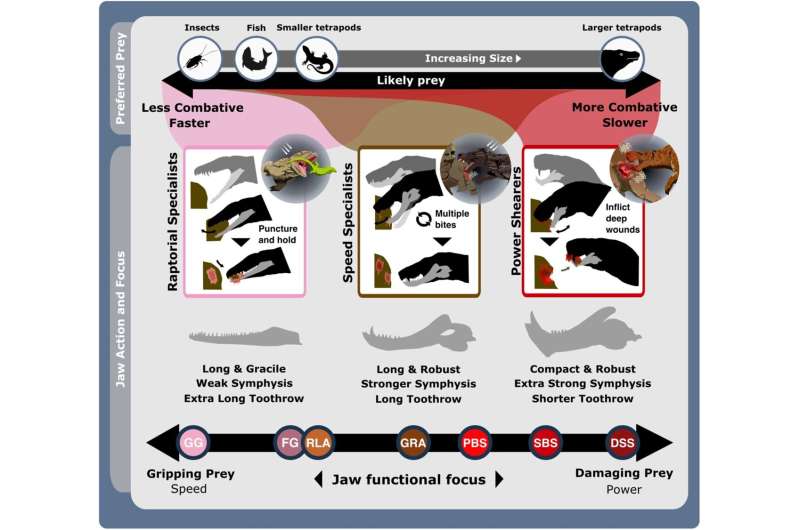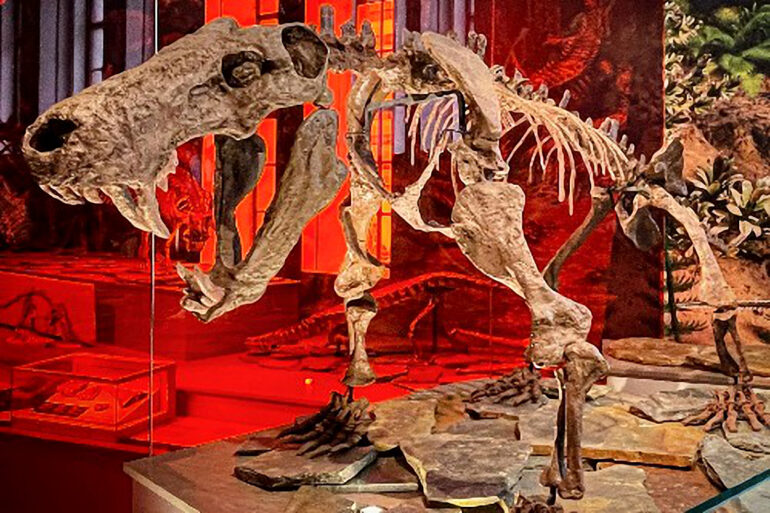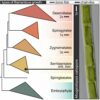The evolutionary success of the first large predators on land was driven by their need to improve as killers, researchers at the University of Bristol and the Open University suggest.
The forerunners of mammals ruled the Earth for about 60 million years, long before the origin of the first dinosaurs. They diversified as the top predators on land between 315–251 million years ago.
Researchers studied the jaw anatomy and body size of carnivorous synapsids, using these traits to reconstruct the likely feeding habits of these ancient predators and chart their ecological evolution through time. They found a major shift in synapsid jaw function roughly 270 million years ago linked to a significant shift in predatory behavior that has important implications for the evolution of our earliest ancestors.
The paper, “Predatory synapsid ecomorphology signals growing dynamism of late Palaeozoic terrestrial ecosystems,” is published in the journal Communications Biology.
As herbivores grew larger and faster, carnivores adapted to become bigger and better predators to survive.
“Earlier synapsid predators such as the famous sail-backed Dimetrodon, had fairly long jaws with lots of teeth to ensure that once they ensnared their prey, it wouldn’t escape,” explained lead author Dr. Suresh Singh based in Bristol’s School of Earth Sciences.
“However, we saw a shift in jaw function toward shorter jaws with greater muscle efficiency and fewer teeth that were concentrated at the front of the jaw—these were jaws adapted to deliver deep, powerful bites.
“The change shows that later synapsid carnivores placed more emphasis on heavily injuring and so more quickly killing their prey. Among these later synapsids were the very first sabertoothed carnivores. This change highlights that predators were facing new selective pressures from their prey.”
This finding provides important context for a key step in synapsid evolution. “The reorganization of synapsid jaws through this time has long been known as a big step towards the evolution of mammals,” added Dr. Armin Elsler, a collaborator on the study.
“These changes don’t just make the jaw more efficient; they also mark the very earliest redevelopment of the jaw that also created the complex ear found in mammals. What drove this first step? Our study suggests that it was partly driven by ecological pressures from their prey.”

The ecofunctional focus of synapsid carnivore functional feeding groups. © Communications Biology (2024). DOI: 10.1038/s42003-024-05879-2
Co-author Dr. Tom Stubbs said, “The timing of the shift in jaw function corresponds with the evolution of new larger, faster herbivores that would have posed a greater challenge for predators to tackle.
“The risks to carnivores of getting injured or killed went up, so some synapsid carnivores became bigger, better killers to overcome these risks.”
This shift reflects a new dynamism in predator-prey interactions that shows that life on land was moving more quickly.
“The late Paleozoic was the time when animals first began to live, eat and reproduce entirely on land,” said Professor Mike Benton, a co-supervisor on the study
“They became fully terrestrial, colonizing new habitats and exploiting new resources further inland from the aquatic environments they’d previously relied on.
“Our findings show how the selective pressures on these early land animals changed as they became better adapted for life on land—catching another animal that can move fast and grow to larger sizes is much more difficult than catching a slippery little fish or amphibian.”
Professor Emily Rayfield also co-supervised the study. She added, “Predator-prey interactions are an important driver of animal behavior today so it’s quite something to see that influence through anatomical evolution over millions of years, and find that they are potentially responsible for driving some big leaps in our own evolutionary history.
“It highlights how paleontologists can use the relationship between form and function to explore how different prehistoric animals may have lived, which can tell us so much about the evolution of life on Earth.”
The researchers also found that synapsid carnivore morphological diversity increased following the shift, with the addition of new functional groups adapted for either faster biting speeds or even more powerful bites through the mid-late Permian—around 265–251 million years ago. By assessing how the sizes of these new carnivore species compared within different communities through time, they realized these communities may have begun to closely resemble those of modern carnivorous mammals.
More information:
Suresh A. Singh et al, Predatory synapsid ecomorphology signals growing dynamism of late Palaeozoic terrestrial ecosystems, Communications Biology (2024). DOI: 10.1038/s42003-024-05879-2
Provided by
University of Bristol
Citation:
Killer instinct drove evolution of mammals’ predatory ancestors, scientists suggest (2024, February 23)



